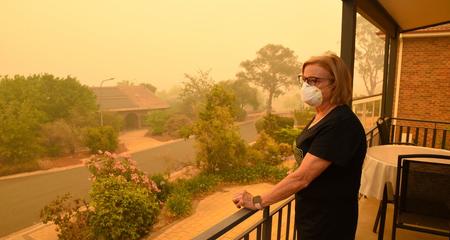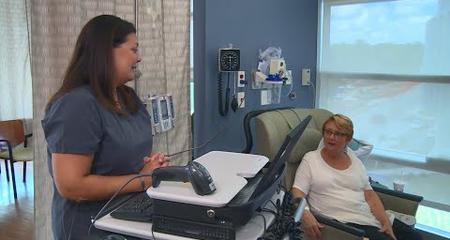Some medical conditions can cause respiratory insufficiency, including Lou Gehrig’s Disease (ALS), various muscular dystrophy diseases, bulbar post-polio syndrome, myasthenia gravis-related disease, as well as more common conditions such as obesity hypoventilation syndrome. Common lung and breathing conditions — such as asthma, pulmonary fibrosis and pneumonia — can also cause respiratory insufficiency.
Our team is made up of highly trained experts, including respiratory therapists, sleep technologists, physicians and nurses who are experienced in caring for patients and helping extend and improve quality of life through a variety of treatment options.
We are unique in that our comprehensive team assesses your needs, monitors the quality of the equipment and coordinates support in the community for ongoing home therapies designed to support respiratory health. We also collaborate with specialists in the areas of ear, nose and throat, neurology, physical medicine and rehabilitation, bariatric medicine and interventional pulmonology to coordinate care plans to achieve the best possible outcomes for our patients.
What Is Respiratory Insufficiency and Its Symptoms
Typically, respiratory insufficiency describes a condition that causes problems with breathing, specifically at rest. The first signs may occur during sleep, leading to poor sleep quality as you experience a low oxygen level, a high carbon dioxide and/or an obstruction of the upper airway (these are collectively disturbances in ventilation). The first symptoms may be feeling tired after sleeping all night, restless sleep or even a headache.
As the condition causing poor ventilation progresses, you may note worsening breathing issues with difficulty laying flat and an increased shortness of breath with simple tasks like getting dressed, or showering. Later symptoms can include poor concentration or even trouble staying awake during the day. Signs there is a ventilation problem include new or worsening leg swelling, low oxygen levels on pulse oximetry (<93%) and abnormal lab results — elevated bicarbonate on a basic chemistry or an elevated hemoglobin on a complete blood count.
Respiratory Insufficiency Causes
The cause of the respiratory insufficiency may be a weakness of any of the muscles of breathing from the upper airway throat muscles to the muscles of the chest and shoulders to the those of the diaphragm.
There are several diseases and conditions that can contribute to this weakness.
- Inherited conditions, such as muscular dystrophies (that can start in childhood or develop as one grows older)
- Conditions that develop without clear cause like amyotrophic lateral sclerosis (ALS, Lou Gehrig's disease)
- Autoimmune conditions, like myasthenia gravis
- Viral infections attacking the nervous system (polio virus, West Nile virus, COVID-19) causing profound weakness that may recover only partially (guillian-barre syndrome, post polio syndrome)
- Obesity — the most common cause — as those struggling with excess weight can develop respiratory insufficiency as a direct result of the excess weight (obesity hypoventilation syndrome)
Many of these conditions have additional features that may allow for the diagnosis before the respiratory muscles are affected including swallowing problems, weakness of grip, trouble climbing stairs or difficulty walking.
Diagnosing Respiratory Insufficiency
Diagnosis of a muscle problem requires collaboration between primary care doctors and clinicians and specialists in neurology and pulmonology. For many diseases, genetic panels, electromyography (EMG) and nerve condition testing can help with diagnosis. For some conditions, special autoimmune labs can lead to the diagnosis and for others a muscle biopsy is required.
Diagnosing respiratory insufficiency requires pulmonary function tests (PFTs) including spirometry and measurement of the pressures generated when inhaling and exhaling forcefully (MIP/MEP). Often a blood gas analysis can provide additional proof (abnormal high carbon dioxide, low oxygen saturation).
Imaging may provide a specific diagnosis if the source is a weak diaphragm. For this a chest X-ray showing an excessive elevated diaphragm may suggest the condition and then a follow-up diaphragm fluoroscopy or SNIFF test can confirm it.
For many, the muscles of the throat may affect sleep first as obstructive sleep apnea, so for many we recommend a sleep study to assess for this condition. In this testing, in addition to obstructive upper airway events, the oxygen level may often be lower than normal for long periods throughout the night even when there are no obstructive upper airway events.
Respiratory Insufficiency vs. Respiratory Failure
Respiratory insufficiency, while serious, is less severe than respiratory failure. Respiratory failure implies a need for some assisting device, such as a ventilator or oxygen. The most common signs of respiratory failure are:
- A high respiratory rate that does not respond to first line therapy or rest
- Sleepiness that is not explained by lack of sleep with evidence of elevated blood carbon dioxide levels
- Cyanosis (blue hue to the lips/mucus members) with a low pulse oximetry reading
Acute Respiratory Insufficiency
If you have no history of breathing issues and develop a respiratory condition that requires some assist device (oxygen, ventilator, cough assist). Pneumonia is an example where a patient may require oxygen for several days to weeks until they recover. With acute respiratory insufficiency, it is a temporary condition as opposed to a chronic condition such as COPD.
Full Spectrum of Respiratory Insufficiency Treatment Options
Support for respiratory insufficiency includes devices that help take over the work to breath or support the upper airway to keep it from flopping closed (obstructive sleep apnea).
Positive pressure devices include CPAP and BIPAP when only needed while sleeping. During the day, noninvasive ventilators allow the person to use supported pressurized breath to improve their ability to cough, to rest while awake and to improve ability to hold a conversation through assisted breaths between sentences (sip ventilator). Often if there is significant throat muscle weakness or weakness of the diaphragm or both, a cough-assist device and suction device are also used to help with clearing secretions quickly with less effort.
Treating Respiratory Failure
Treating acute respiratory failure usually requires a hospital stay and treatment of the primary cause of the respiratory failure — and also providing supportive respiratory care (oxygen, ventilator support, nebulized medications to clear secretions).
When a chronic condition — such as COPD, ALS or muscular dystrophy — brings on respiratory failure over time, we monitor oxygen levels when sleeping, perform pulmonary function testing and appropriately analyze arterial blood gas analysis to indicate when to initiate breathing support. This typically involves all of the same support devices that are used in acute care settings but are introduced over time by the pulmonary provider to the patient and their caregivers with the help of home respiratory therapists.
Team Approach to Treatment
Our team works across our health network to provide a collaborative and comprehensive treatment plan tailored to our patients’ needs, including:
- Ongoing education and direct support for those who require a device to assist them with breathing (examples: CPAP, BIPAP, noninvasive ventilator assist devices, invasive ventilator devices, devices to mobilize secretions, oxygen)
- State-of-the-art pulmonary diagnostics, with the latest options to accurately diagnose lung and respiratory disease
- State-of-the-art sleep labs that allow the application of advanced respiratory support devices during sleep to confirm that they are effective
- Expertise in transitioning to invasive mechanical ventilation with tracheostomy placement when appropriate
- Referrals for outpatient pulmonary rehabilitation or physical therapy when appropriate
Virtual Visits Are Available
Safe and convenient virtual visits by video let you get the care you need via a mobile device, tablet or computer wherever you are. We'll assess your condition and develop a treatment plan right away. To schedule a virtual visit, call 414-777-7700.
Recognized as High Performing by U.S. News & World Report
Froedtert Hospital is recognized by U.S. News & World Report as high performing in pulmonology and lung surgery, lung cancer surgery, chronic obstructive pulmonary disease (COPD) and pneumonia care. Froedtert Menomonee Falls Hospital is also recognized as high performing for COPD.
Blogs, Patient Stories, Videos and Classes





